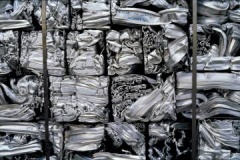Difference between revisions of "Aluminium Waste"
| Line 8: | Line 8: | ||
}} | }} | ||
==Description== | ==Description== | ||
| + | [[Aluminium]] recycling is the process by which scrap aluminium can be reused in products after its initial production. The process involves simply re-melting the metal, which is far less expensive and energy intensive than creating new aluminium through the electrolysis of aluminium oxide (Al2O3), which must first be mined from bauxite ore and then refined. Recycling scrap aluminium requires only 5% of the energy used to make new aluminium. For this reason, approximately 31% of all aluminium produced in the United States comes from recycled scrap. Used beverage containers are the largest component of processed aluminum scrap, with most UBC scrap manufactured back into aluminum cans.<br><br> | ||
| + | Sources for recycled aluminium include aircraft, automobiles, bicycles, boats, computers, cookware, gutters, siding, wire, and many other products that need a strong light weight material, or a material with high thermal conductivity. As recycling does not damage the metal's structure, aluminium can be recycled indefinitely and still be used to produce any product for which new aluminium could have been used.<br><br> | ||
| + | The recycling of aluminium generally produces significant cost savings over the production of new aluminium even when the cost of collection, separation and recycling are taken into account. Over the long term, even larger national savings are made when the reduction in the capital costs associated with landfills, mines and international shipping of raw aluminium are considered.<br><br> | ||
Distinction must be made between:<br> | Distinction must be made between:<br> | ||
| − | * Scrap from used objects such as plates, [[tubes]], tanks, water kettles, etc (harmless) | + | * Scrap from used objects such as plates, [[tubes]], tanks, water kettles, etc (harmless) |
| − | * Scrap produced during the manufacturing of objects such as borings, cuttings, filings shavings and turnings (dangerous; mainly contaminated with oil) | + | * Scrap produced during the manufacturing of objects such as borings, cuttings, filings shavings and turnings (dangerous; mainly contaminated with oil) |
| − | * Scrap generated through the production of | + | * Scrap generated through the production of aluminium, as dross, skimming (almost always dangerous).<br><br> |
| − | + | ||
| − | Aluminium | + | Aluminium is a very expensive non ferrous metal and can therefore produce high incomes for recycling schemes. Alumium waste is produced primarily from two main streams, the production lines of aluminium industry and the alumium as an end-of-life product, after its use by the consumers. In both cases the option of recycling is favourable and widely implemented in many parts of the developed world. |
| − | + | ||
| − | |||
| − | |||
[[Category:Metals and steel]] | [[Category:Metals and steel]] | ||
[[Category:Products]] | [[Category:Products]] | ||
Revision as of 11:37, 3 October 2012
| Infobox on Aluminium Waste | |
|---|---|
| Example of Aluminium Waste |  |
| Facts | |
| Origin | - |
| Stowage factor (in m3/t) | - |
| Humidity / moisture | - |
| Ventilation | - |
| Risk factors | Aluminium dross, aluminium residues and aluminium skimming are listed; reference is made to the relevant IMO regulations of hazardous cargo. |
Aluminium Waste
Contents
Description
Aluminium recycling is the process by which scrap aluminium can be reused in products after its initial production. The process involves simply re-melting the metal, which is far less expensive and energy intensive than creating new aluminium through the electrolysis of aluminium oxide (Al2O3), which must first be mined from bauxite ore and then refined. Recycling scrap aluminium requires only 5% of the energy used to make new aluminium. For this reason, approximately 31% of all aluminium produced in the United States comes from recycled scrap. Used beverage containers are the largest component of processed aluminum scrap, with most UBC scrap manufactured back into aluminum cans.
Sources for recycled aluminium include aircraft, automobiles, bicycles, boats, computers, cookware, gutters, siding, wire, and many other products that need a strong light weight material, or a material with high thermal conductivity. As recycling does not damage the metal's structure, aluminium can be recycled indefinitely and still be used to produce any product for which new aluminium could have been used.
The recycling of aluminium generally produces significant cost savings over the production of new aluminium even when the cost of collection, separation and recycling are taken into account. Over the long term, even larger national savings are made when the reduction in the capital costs associated with landfills, mines and international shipping of raw aluminium are considered.
Distinction must be made between:
- Scrap from used objects such as plates, tubes, tanks, water kettles, etc (harmless)
- Scrap produced during the manufacturing of objects such as borings, cuttings, filings shavings and turnings (dangerous; mainly contaminated with oil)
- Scrap generated through the production of aluminium, as dross, skimming (almost always dangerous).
Aluminium is a very expensive non ferrous metal and can therefore produce high incomes for recycling schemes. Alumium waste is produced primarily from two main streams, the production lines of aluminium industry and the alumium as an end-of-life product, after its use by the consumers. In both cases the option of recycling is favourable and widely implemented in many parts of the developed world.











